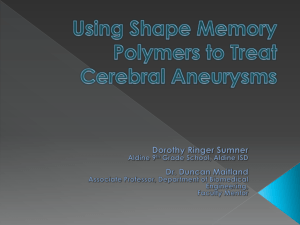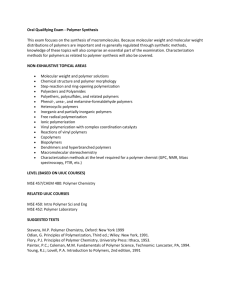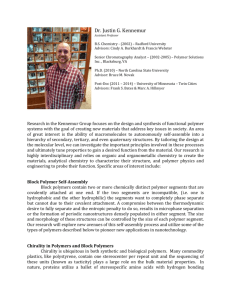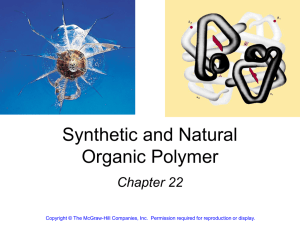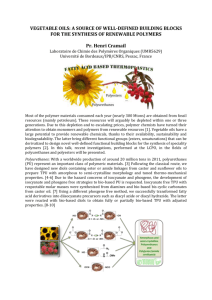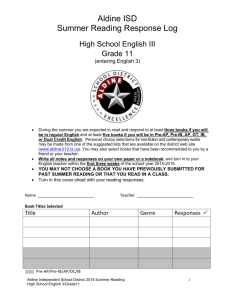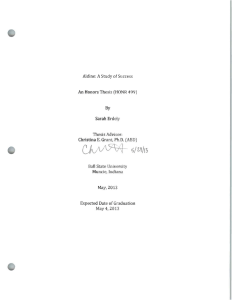Ringer Sumner - End of Summer Report
advertisement
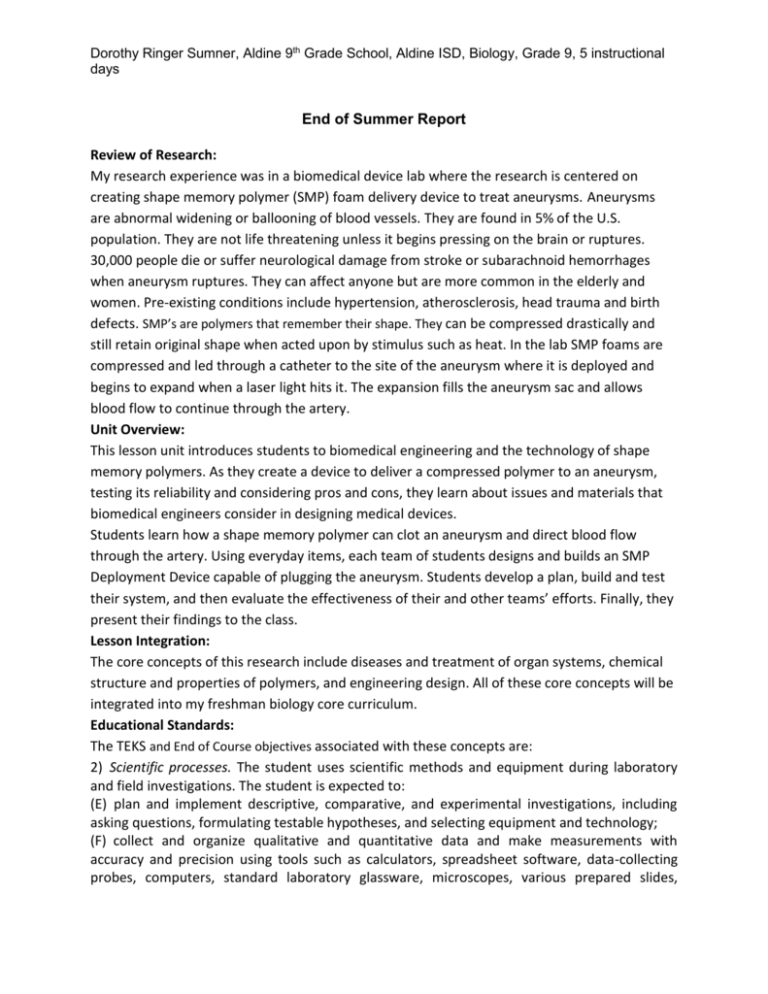
Dorothy Ringer Sumner, Aldine 9th Grade School, Aldine ISD, Biology, Grade 9, 5 instructional days End of Summer Report Review of Research: My research experience was in a biomedical device lab where the research is centered on creating shape memory polymer (SMP) foam delivery device to treat aneurysms. Aneurysms are abnormal widening or ballooning of blood vessels. They are found in 5% of the U.S. population. They are not life threatening unless it begins pressing on the brain or ruptures. 30,000 people die or suffer neurological damage from stroke or subarachnoid hemorrhages when aneurysm ruptures. They can affect anyone but are more common in the elderly and women. Pre-existing conditions include hypertension, atherosclerosis, head trauma and birth defects. SMP’s are polymers that remember their shape. They can be compressed drastically and still retain original shape when acted upon by stimulus such as heat. In the lab SMP foams are compressed and led through a catheter to the site of the aneurysm where it is deployed and begins to expand when a laser light hits it. The expansion fills the aneurysm sac and allows blood flow to continue through the artery. Unit Overview: This lesson unit introduces students to biomedical engineering and the technology of shape memory polymers. As they create a device to deliver a compressed polymer to an aneurysm, testing its reliability and considering pros and cons, they learn about issues and materials that biomedical engineers consider in designing medical devices. Students learn how a shape memory polymer can clot an aneurysm and direct blood flow through the artery. Using everyday items, each team of students designs and builds an SMP Deployment Device capable of plugging the aneurysm. Students develop a plan, build and test their system, and then evaluate the effectiveness of their and other teams’ efforts. Finally, they present their findings to the class. Lesson Integration: The core concepts of this research include diseases and treatment of organ systems, chemical structure and properties of polymers, and engineering design. All of these core concepts will be integrated into my freshman biology core curriculum. Educational Standards: The TEKS and End of Course objectives associated with these concepts are: 2) Scientific processes. The student uses scientific methods and equipment during laboratory and field investigations. The student is expected to: (E) plan and implement descriptive, comparative, and experimental investigations, including asking questions, formulating testable hypotheses, and selecting equipment and technology; (F) collect and organize qualitative and quantitative data and make measurements with accuracy and precision using tools such as calculators, spreadsheet software, data-collecting probes, computers, standard laboratory glassware, microscopes, various prepared slides, Dorothy Ringer Sumner, Aldine 9th Grade School, Aldine ISD, Biology, Grade 9, 5 instructional days stereoscopes, metric rulers, electronic balances, gel electrophoresis apparatuses, micropipettes, hand lenses, Celsius thermometers, hot plates, lab notebooks or journals, timing devices, cameras, Petri dishes, lab incubators, dissection equipment, meter sticks, and models, diagrams, or samples of biological specimens or structures; 3D) evaluate the impact of scientific research on society and the environment; 9) Science concepts. The student knows the significance of various molecules involved in metabolic processes and energy conversions that occur in living organisms. The student is expected to: (A) compare the structures and functions of different types of biomolecules, including carbohydrates, lipids, proteins, and nucleic acids; (10) Science concepts. The student knows that biological systems are composed of multiple levels. The student is expected to: (A) describe the interactions that occur among systems that perform the functions of regulation, nutrient absorption, reproduction, and defense from injury or illness in animals; (B) describe the interactions that occur among systems that perform the functions of transport, reproduction, and response in plants and animals. Learning objectives: The students will: --Describe various diseases of the circulatory system and how advances in engineering, technology and scientific research are being used to treat them. -Use knowledge from the study of organic polymers to know what polymer is created from a particular monomer. -Be able to recall and describe the organic polymers (proteins, carbohydrates, lipids and nucleic acids) that exist in the human body; -Explain some of the wide range of different properties and uses of polymers; -Know that some polymers occur naturally and others are designed and still others were discovered by accident. -Plan, develop, and test a design apparatus. -Think creatively about the implications of a scientific discovery and how it could be put to use. -Discover how biology, technology and manufacturing are linked. Instructional Strategies: Students will engage in the following activities: a. Independent activities b. Whole group instruction c. Cooperative learning d. Simulations e. Hands-on activities f. Process skill activities g. Visuals Dorothy Ringer Sumner, Aldine 9th Grade School, Aldine ISD, Biology, Grade 9, 5 instructional days h. Collaborative grouping Outline: Day 1 Use power point to discuss the structure and function of the circulatory system and diseases of the system. Have student trace the path of blood through the heart to major areas of the body. Discuss the diseases described in the power point notes and new therapies for treatment including aneurysms. Discuss lifestyle changes a person with heart disease may benefit from. Explain to students that they will design a device to treat aneurysms by simulating the technology described in the power point presentation. Day 2 Introduce shape memory polymers using a powerpoint presentation, “Weird and Wonderful Polymers”. Describe the procedures for making a SMP. Students will make the SMP’s. Students will complete a chart describing the various uses of the SMP’s using their notes homework. Day 3 Students will experiment with deforming polymers and complete the lab conclusions for homework. Demonstrate how the polymer polyacrylate (found in diapers) absorbs liquid. Explain to the students that they will use this substance as their SMP when creating their device. Pass out assignment with criteria for the creation of the deployment device to treat aneurysms. Students will create an aneurysm with a straw heated to deform it. Students will discuss ways to plug or clot the aneurysm by creating their device using the given material list. Homework: Continue to brainstorm ways to create device. Day 4&5 Design device to treat aneurysm. The device must be able to allow a syringe of simulated blood to flow through the artery. Record the delivery of the polymer and blood flow through artery to determine the effectiveness of the device. Present team models and results to class. Summary: Upon completion of this unit, students will: -be familiar with cardiac diseases, risk factors, treatment therapies and prevention methods. - know examples of natural and synthetic polymers and their properties and uses. - understand how biology, technology and manufacturing are linked. - apply engineering design techniques in problem solving. Dorothy Ringer Sumner, Aldine 9th Grade School, Aldine ISD, Biology, Grade 9, 5 instructional days CARDIAC DISEASES AND TREATMENT DEVICES PRE- & POST-TEST Answer each of the following on your scantron. 1) a) b) c) d) An aneurysm occurs when __________. blood clots in the heart. the heart beats irregularly. an artery widens or balloons out of shape. a vein collapses. 2) a) b) Aneurysms are only life threatening when they rupture or press on the brain. true false 3) a) b) c) d) Which of the following increases the chance of developing an aneurysm? hyperthyroidism hypertension dwarfism emphysema 4) a) c) d) Which set contains one natural polymer and one synthetic polymer? polyethylene and nylon protein and starch protein and polyacrylate 5) a) b) c) d) A polymer that returns to its original shape after being deformed is________. plastic polymer shape memory polymer hydrogel polymer petrochemical polymer 6) What tissue makes up most of your heart? a) fat b) muscle c) connective tissue d) blood vessels 7) What needs the nutrients and oxygen carried by your blood? a) organ systems b) organs c) tissues d) individual cells Dorothy Ringer Sumner, Aldine 9th Grade School, Aldine ISD, Biology, Grade 9, 5 instructional days 8) a) b) c) d) Blood returning from the lungs enters the heart through the: pulmonary valve mitral valve right ventricle left atrium 9) a) b) c) d) In general, veins exhibit this characteristic when compared to arteries: are thinner walled are more elastic carry faster moving blood have thicker endothelium 10) a) b) c) d) Which of the following is NOT a risk factor for developing atherosclerosis? high dietary fat intake diabetes smoking high HDL level
